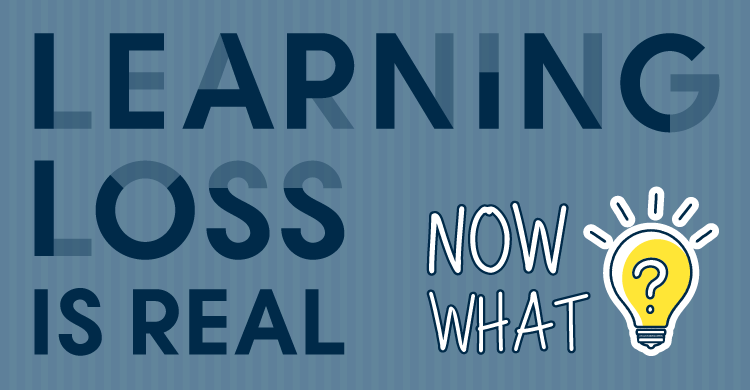For the multiple decades that I have been an educator and even before, we have tried to help students catch up by remediating learners or going backwards to go forward. This is the usual approach to help students overcome learning loss especially for those students who are far below grade level in reading, writing, or mathematics. Although this may help to fill some of a student’s learning gaps it does not help them to reach grade-level knowledge and skill proficiency fast enough for the majority of students to catch up with their peers. Unfortunately, this school year has truly exacerbated learning loss for almost every student. If this situation is not fully addressed or simply a case of remediation or going backwards to go forward, the sheer number of students who do not learn at grade level or beyond will increase. In addition, as each school year and course marches on students get farther and farther behind creating a cycle of remediation that is hard to escape. In fact, it can seem like a life sentence for most students. The gap between those students who are achieving grade level learning and those that are not gets wider and wider as a student matriculates through each school year. We cannot continue to go backwards to go forward. It widens the achievement gap and inequities in our system become even more pronounced.
As each school attempts to respond to the apparent learning loss that has occurred many are developing units from previous grade levels or utilizing materials that were missed which only serves to create more learning loss because time marches on and each new year will have to begin the exact same way in the future. That means we will need to continue to go backwards to go forward. This is not a strategy that will serve our students well. It will have a definite impact on their progress throughout their years in school. It is especially detrimental to students who were already behind prior to this school year.
If we believe that all kids can learn when all really means all then this compelling question immediately becomes the elephant in the room. Ensuring learning for all begs the overwhelmingly compelling question, Is it really possible to get all students to learn at grade level and beyond? And if the answer is a resounding yes, then how? This inevitably leads to even more questions: What strategies, practices, policies, and procedures need to be in place to ensure high levels of learning for all? Where do educators begin? What is proven to work with the students who are often missing essential prerequisite skills and knowledge to even begin to learn grade- or course-level content? What strategies are effective in supporting special education students and students who are learning English? How can teachers accelerate learning instead of using remediation to address students’ needs?
The newly released anthology, Charting the Course for Collaborative Teams: Lessons From Priority Schools in a PLC at Work, takes the reader on an alternate journey by providing acceleration strategies that close the achievement gap quickly enough to access grade and course level learning. Each chapter examines specific and practical strategies that teachers, teams, and schools can implement to ensure learning for all is a reality. This collection addresses the most pressing problems of practice as teams of teachers work together to close the achievement gap. Each of the authors of this anthology understand the overwhelming need to go forward not backwards to ensure students learn.
The chapters help teams solve specific problems that schools are in the midst of addressing right now. Each chapter features research-supported practices, which is important, but always keep in mind the best, most actionable books provide both the knowledge and the means to easily apply their contents to real-world situations. There are strategies, resources, and templates to support the actions that are described. The authors offer solutions to many of the challenges that surface as we work to alleviate learning loss. It includes pressing and timely topics such as:
- Utilizing data to move the learning forward
- Creating a learning cycle that supports all learners
- Teaching specific behavioral/learner characteristics with a focus on learning
- Rethinking SMART team goals to include audaciously attainable not just safely attainable
- Answering PLC question 1 from the point of view of an English learner
- Getting students to grade-level reading fast
- Working together to ensure all students learn mathematics
- Moving from most students needing intensive interventions to a more balanced system of support
- Making the proficient students a priority especially as we tackle learning loss for others
Practical Applications
The common thread throughout this book is the deeply held belief that even at priority schools and with learning loss, all students can learn at high levels, and it is every team’s responsibility to get them there. The topics covered may not be new, but the value of each chapter lies in the practical applications and examples each presents to address the ongoing issues that plague schools and get in the way of real improvement. Although the book is intended to be read in its entirety, it can also serve to address specific problems on a chapter-by-chapter basis. Each chapter is comprehensive and provides learning experiences you can share within your collaborative team, with your leadership team, or with an entire staff. This book is useful for all educators seeking improvement. The practices, strategies, and protocols you will find in each chapter are essential for some and good for all.
The issues and challenges that surfaced as we worked though the past school year and the ever growing need to reach all learners also represent huge opportunities for growth that is indescribably rewarding for all educators. If we choose to see things through a strength-based lens versus a deficit mindset the possibilities are endless. What do the students already know and can do versus what are they missing is an example of strength-based lens. As we examine the needs of our students the focus must be on what they know, not how behind they have become. If we seek out a growth mindset for ourselves and the students we serve, the results will be amazing. We can use this time to build student self-efficacy and also enhance our collective efficacy as we work together in collaborative teams. If we truly believe that we can come back even better than before, we will instill the growth mindset in our students that propels learning. This builds an acceleration pathway that will close the achievement gap and ensure learning for all. Learning loss is real, but there are real practical ways to move learning forward quickly.






